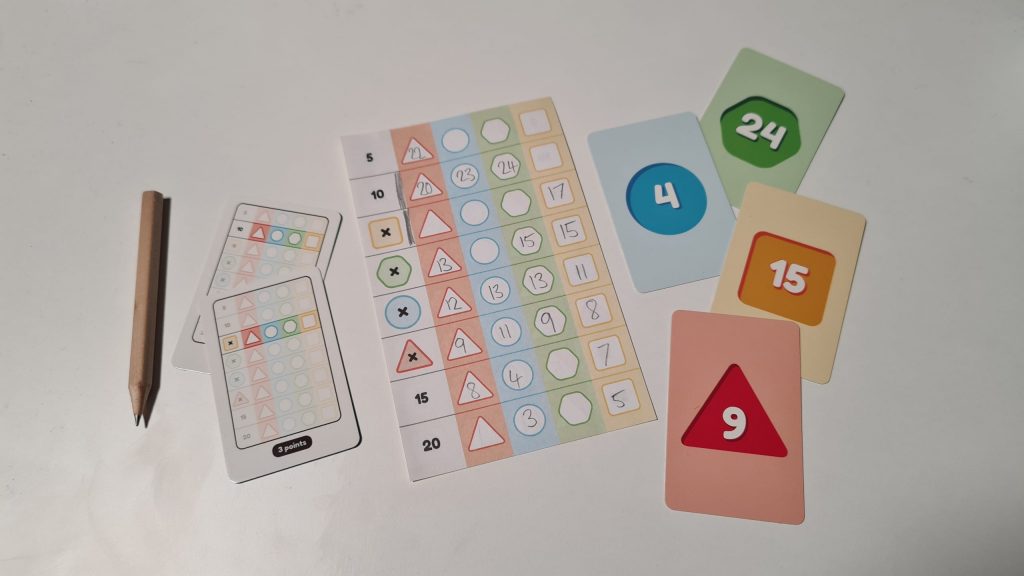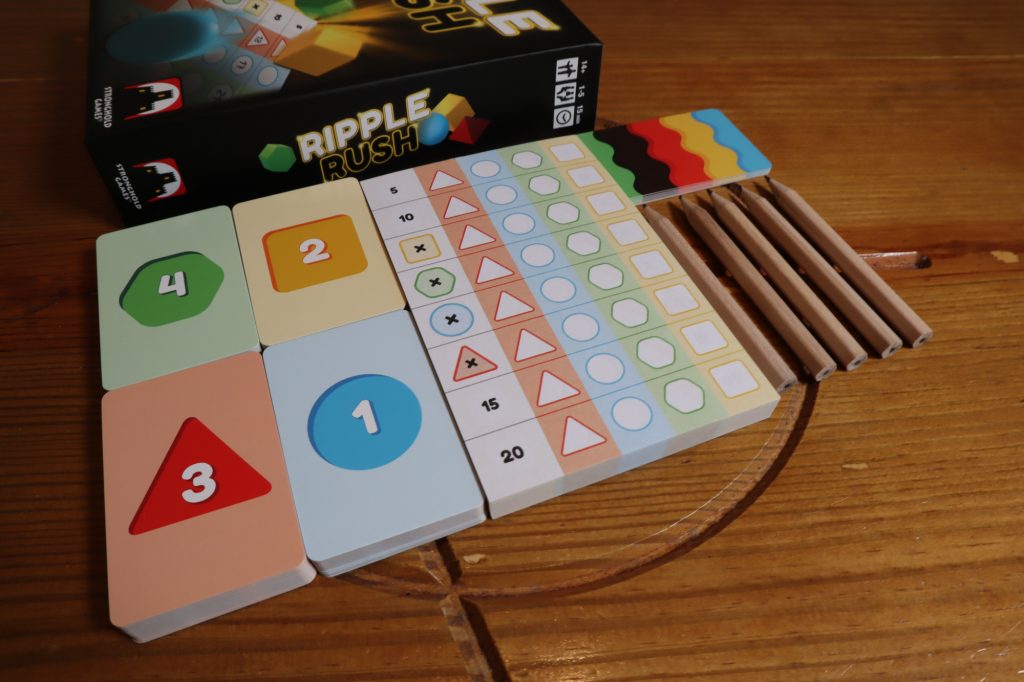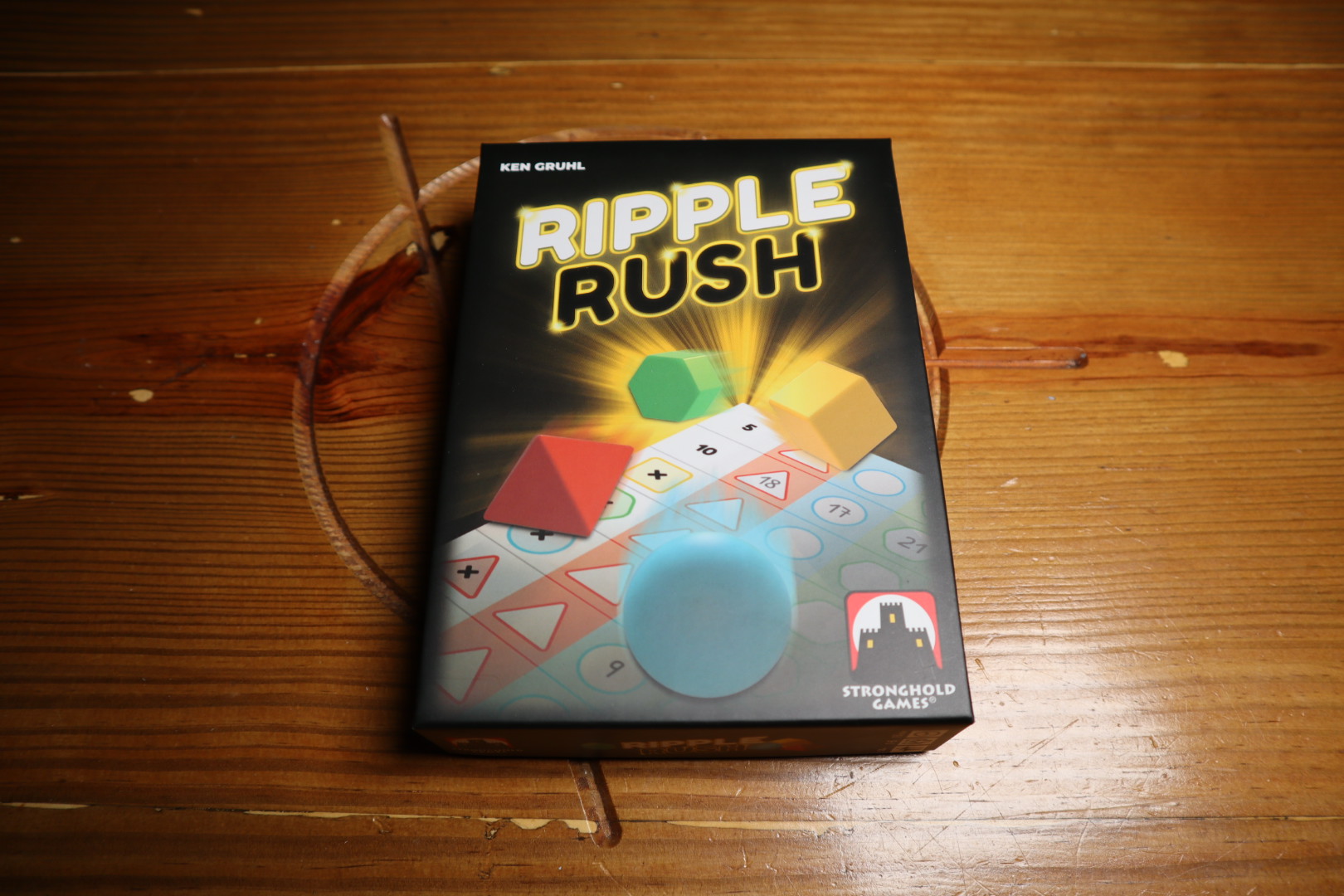Ripple Rush is a brand new flip and write style board game from publisher Stronghold Games. Designed by Ken Gruhl, Ripple Rush sees 1 – 5 players flipping cards and filling in numbers on their individual scoresheets. Taking around 10 minutes to play, columns will be filled, bonuses triggered and points earnt. However, do players get a rush when playing, or is it just a ripple in the ocean? Let’s find out!
The deck of Ripple Rush features numbers of 1 – 25 on 4 different colours. At the start of the game the deck is shuffled and per player 20 cards are added to a central draw pile – with the rest returned to the box. Therefore, in a 3 player game 60 random cards are in play. Each player takes a scoresheet and fetches a pen, then the game is ready to go.
As a general rule players will be writing numbers into the four coloured columns on their scoresheets, with numbers needing to be in ascending order as you go up the spaces of the column. Each round consists of a few simple stages, which players perform simultaneously. Each player draws a card from the central deck. Revealing the cards, players determine if they can use the number on their card. If unable to use the number, thanks to not having a space to write it legally, the player must let the others know. Players that can write the number must write it onto their scoresheet in the column matching the colour of the card. At this point, players are then able to write numbers that weren’t used by other players.

Played over 20 rounds players will keep repeating this process, though there are bonuses to be triggered. Whenever someone fills in a number in each space of a row, one of each colour, an indicated bonus is triggered. The top two and bottom two rows trigger specific numbers. For example, filling in the bottom row allows that player to freely write a 20 into any of the colour columns. The middle 4 rows instead of featuring numbers feature colours. These see the player able to write any number in any space of the indicated colour column, following the normal low to high ordering. Bonuses can go on to trigger other bonuses, if used to finish another row, so players can at times write many numbers in a single round.
At the end of the game there isn’t a complicated scoring system. Instead, players score points based on connected sequences of numbers on their sheets. For each of the four coloured columns players count the number of connected spaces that they wrote numbers into. If they have two sections of linked numbers that are not joined the larger grouping scores. Players gain 1 point per number in the connected group, with numbers having to be ascending but not necessarily consecutive. Whoever has the most points wins, with ties split by the most complete columns.
After a game or two, players will probably want to move onto the advanced variant. During setup two goal cards are revealed, randomly from the deck. These depict a specific row that if completed not only triggers the normal bonus but at the end of the game scores 3 points. Note that in the current printing there is a minor typo when it comes to the advanced variant. In an example it suggests a player gets 8 points for completing the 2 cards. However, it is 3 points each, as written in the rest of the rulebook and on the goal cards themselves. These goal cards could have used patterns or diagonals to be that bit more interesting, rather than just rows which you naturally want to complete anyway to trigger the bonus actions.

In the first couple of games players seem to play timidly. Spacing out the numbers to always allow room for future numbers results in almost no rows being completed. As completing rows triggers bonuses, or points if using the advanced variant, then it does become clear players will have to risk something now and again. When this step is made then Ripple Rush starts to tick, as it is the ability to combo writing a number and triggering a bonus number that gives the game that something special. Also the amount of numbers coming from opponents increases. While it can be frustrating to be giving opponents a free extra number the more their sheets fill up the more likely they will be unable to use a card in the future – so that balances some of the luck of the draw.
Production wise Ripple Rush is generally decent, with a mistake or two and without having much of a wow factor. Putting aside the typo in the rulebook, one glaring absence from the 6 and 9 value cards are that little line that helps players know which it is at a glance. As there is no underlining it can be hard to tell which is which instantly. This is even the case on the red triangles where the triangle makes it easier to see which is the right way up. It isn’t to the extent that you cannot work out what is a 6 or a 9, yet it slows the experience down a bit. Aside from this, the cards themselves are vibrantly coloured, and this colouring extends to the scoresheets. While it is nice to see that the scoresheets are double sided, the cards are on the small side for shuffling.
Ripple Rush is a fast paced flip and write experience. At the start players will be flipping over and writing single numbers. Before long players will have choices to make: do they think many numbers lower or higher will come out of the deck and should they take risks? Risks inevitably cause people to be unable to write numbers, which then gives others bigger turns. When you have finished one game you can instantly see what you could or should have done differently and that makes you want to replay. Helpfully, you can easily do this by flipping over the scoresheet and reshuffling the cards. Ripple Rush might not grab much attention from the components, and writing only a number or two a turn might not sound like much. Still, it is an experience that makes you want to play more!
(Editor’s Note: Ripple Rush was provided to us by Asmodee for the review. The game is currently available from local board game stores! Find your local store here.)

